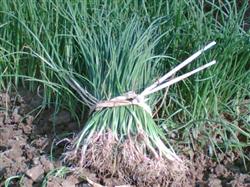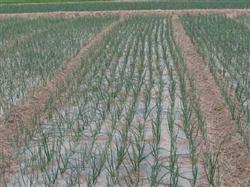How to manage onions for high yield?

How to manage onions for high yield? Please give instructions to plant onions in order to achieve high yield, you can refer to the following planting methods: first, it is better to cultivate strong seedlings from the end of September to the middle of October. The nursery land should choose loose and fertile sandy loam or new land with convenient drainage and irrigation and unplanted onion and garlic. Before sowing, the soil should be carefully prepared, enough fertilizer should be applied, and the seeds should be sown in flat beds. Soak in warm water for 24 hours before sowing, dry and mix the crushed soil and sow evenly. Need to sow 70-75 grams per mu of seedling bed, cover with fine soil after sowing, and then cover with weeds to prevent Rain Water erosion and direct sun exposure. After covering the grass, sprinkle dilute dung water, and sprinkle insect control drugs around the bed, and remove the covered weeds after the seedlings are unearthed. During the seedling period, dilute and rotten manure water was drenched every 5-6 days, and it could be transplanted in about 40 days at the seedling stage. Second, choose the land to fertilize onions and avoid continuous cropping, and the planting sites should choose the bases for planting eggplant fruits, melons and beans in the previous crop and rice in the late season, especially in loose and fertile sandy loam or newly reclaimed land. Before planting, 25 kg of lime per mu was used for soil disinfection, and 1500-2000 kg of high-quality mature soil fertilizer was used as base fertilizer. From the border planting, border width 80-100 cm, border height 25-30 cm, border surface soil layer should be loose, fine broken, flat. Third, scientific planting is generally planted from mid-November to early December, so that the seedlings grow rapidly before "Greater Cold" and will not suffer frost damage. The planting specifications are as follows: plant spacing 10-12 cm, row spacing 14-16 cm, planting depth 2-3 cm, about 8000 plants per mu. After the seed is drenched with root water, it is beneficial to survive. 4. 7 days after topdressing and transplanting, thin human and animal manure water was applied once, and burning soil or high-quality soil fertilizer was applied again every 7-8 days to promote rooting and enhance cold resistance. In the severe cold season, onion seedlings grow slowly, so topdressing can be suspended. In late February of the following year, when the bulb entered the expansion period, fertilizer should be applied 1-2 times, 10-12 kg urea per mu plus 5-6 kg potassium sulfate per mu. The bulb expanded rapidly in late March, and 1250 kg of rotten human feces and urine were applied per mu, and fertilization was stopped 25 days before harvest. Fifth, properly watering onions like to be wet and avoid stains. In the early stage, the seedlings are small, the temperature is low, and the water demand is less, so keep the border soil moist. After the spring is warm, the temperature is getting higher and higher, the growth rate of onion is accelerated, and a large number of bulbs form and enter the expansion period, which requires more water and should be drenched with enough water. However, when there are more Rain Water in spring, it is necessary to timely dredge ditches and drainage to prevent stagnant water in the fields. Stop watering 10 days before harvest to facilitate harvest and avoid bulb storage due to high water content. The diseases that often occur in onions are soft rot and stem rot. ⑴ applies rotten fertilizer to prevent it from carrying bacteria. During the growing period, the application amount of nitrogen fertilizer should be controlled, and fertilization should be combined with nitrogen, phosphorus and potassium. ⑵ bulb formation period should pay attention to timely drainage to avoid long-term accumulation of water. Before the onset of ⑶, the following agents were used: 72% agricultural streptomycin 4000 times solution, 405 Fuxing EC 8000 times solution sprayed alternately. Timely harvest when the leaves of the plant gradually turn yellow and the basal leaves begin to dry up, the onion has stopped growing and expanding, that is, it should be harvested in time. Cut off the onion seedlings during harvest and try not to damage the onions to facilitate storage and transportation. Click to get more onion planting techniques click to get more vegetable planting techniques
- Prev

How to transplant onions
How to transplant onions? Please introduce in detail the transplanting of onions: timely planting onions and avoiding continuous cropping, applying high-quality rotten organic fertilizer 4000 / mu, diammonium phosphate 40 / 50kg, potassium sulfate 30kg / mu. The land is leveled into a border, and the width of the border depends on the width of the plastic film. Water before covering the film, and spray 33 mu after the water seeps.
- Next

Why do onions fork?
How to grow onions? Please introduce the planting methods of onions, please refer to the following: 1. Variety selection of onions is generally divided into three types: red onions, white onions, and yellow onions. The main excellent varieties are water chestnut flat, big peach, yellow onion, purple onion, Xiongyue onion, red onion and so on. 2. Land preparation.
Related
- Where is it suitable to grow horseradish in China? it is expected to see the middle altitude horseradish in Alishan.
- How to prevent tomato virus disease reasonably? (Control methods included)
- Many people like to plant towel gourd on the balcony. What are the main points of this method and management?
- What crops can chili peppers be mixed with?
- Fertilization techniques and matters needing attention in Tomato
- What are the grafting techniques for peach seedlings in spring?
- Harm and control methods of root swelling disease of Chinese cabbage
- What are the pests of sweet potatoes? How to prevent and cure it?
- Symptoms, causes and Control methods of navel Rot in Tomato
- The cause of "Cucumber rotten bibcock" in Farmers' planting Cucumber and its Control Plan

